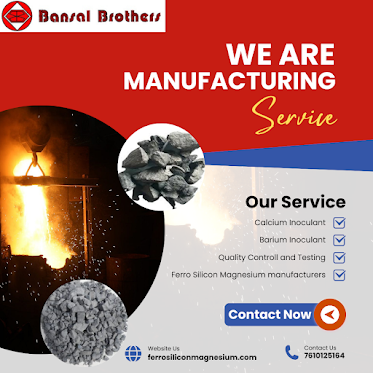Top 5 Technological Advancements in Ductile Iron Casting and Production
The foundry industry has come a long way from traditional casting practices. With growing demand for stronger, more durable, and eco-efficient metals, ductile iron has become a cornerstone material in automotive, machinery, and infrastructure applications. What makes ductile iron stand out is its strength, flexibility, and shock resistance, which are achieved through innovative metallurgical techniques and precise alloying — particularly with ferro silicon magnesium.
In this article, we’ll explore the top five Modern Techniques For Ductile Iron casting and production that are redefining quality, efficiency, and performance across global foundries.
1. Advanced Inoculation Using Ferro Silicon Magnesium
One of the most critical steps in ductile iron production is Nodularization, which transforms regular graphite flakes into spheroidal nodules — giving ductile iron its signature strength and flexibility. This transformation is achieved using ferro silicon magnesium (FeSiMg), a master alloy that provides controlled magnesium and silicon content during treatment.
How It Works:
Ferro silicon magnesium acts as a nodularizer by introducing magnesium into the molten iron.
Magnesium removes sulfur and oxygen, allowing graphite to form as round nodules rather than flakes.
The silicon component stabilizes the iron matrix and improves casting quality.
Benefits:
Produces uniform nodule structure for higher tensile strength.
Reduces casting defects like shrinkage and porosity.
Enhances machinability and toughness.
Today’s foundries use precisely engineered ferro silicon magnesium alloys to ensure consistent nodularity and to meet the stringent quality demands of automotive and heavy-duty industries.
2. Automated Magnesium Treatment Systems
Manual addition of Ferro Silicon Magnesium in molten iron once posed safety and consistency challenges. Modern foundries now rely on automated magnesium treatment systems, which ensure precise control over Nodularization.
Modern Technique for Ductile Iron – Automation in Action:
The treatment ladle is pre-loaded with a measured amount of FeSiMg alloy.
Molten iron is poured under controlled conditions to minimize violent reactions.
Advanced dosing systems automatically adjust the magnesium addition based on temperature and composition.
Advantages:
Consistent quality: Uniform nodule count and size distribution.
Increased safety: Controlled reaction minimizes splashing and fume generation.
Cost-efficiency: Reduces alloy waste and improves yield rates.
Automation is now one of the most important modern techniques for ductile iron production, ensuring repeatable quality and safer working environments.
3. Thermal Analysis and Real-Time Metallurgical Control
Traditional quality control methods relied heavily on post-casting inspection. However, the new generation of foundries uses thermal analysis systems that provide real-time feedback on molten iron composition.
How It Improves Production:
Thermal analysis measures solidification patterns to determine carbon equivalent, silicon levels, and nodule potential.
Foundry engineers can instantly adjust ferro silicon magnesium additions or temperature settings.
Real-time data helps maintain the ideal balance of magnesium recovery and graphite morphology.
Impact on Quality:
Reduces casting defects caused by improper Nodularization.
Enhances metallurgical consistency across multiple batches.
Supports predictive control, reducing downtime and rework.
By integrating smart sensors and AI-assisted analytics, this modern technique for ductile iron production is setting new standards in process reliability and efficiency.
4. Vacuum and Pressure-Controlled Casting Systems
The evolution of vacuum and pressure casting technology has significantly enhanced the precision of ductile iron components. These controlled systems ensure minimal gas entrapment and improved metal flow, crucial for complex castings used in automotive and energy sectors.
Process Overview:
Molten ductile iron, treated with ferro silicon magnesium, is poured under vacuum or low-pressure conditions.
The controlled environment reduces oxidation and gas inclusions.
The result is dense, defect-free castings with improved dimensional accuracy.
Key Benefits:
Improved surface finish and mechanical integrity.
Higher yield rates and reduced scrap production.
Better alloy retention, as magnesium loss is minimized during controlled pouring.
This modern technique for ductile iron casting is especially popular for precision components like crankshafts, turbocharger housings, and heavy-duty gear parts.
5. Computer-Aided Simulation and Solidification Modeling
The introduction of 3D simulation software has transformed how foundries design and optimize their ductile iron casting processes. Using advanced algorithms, engineers can predict flow behavior, temperature gradients, and solidification patterns before actual production begins.
Modern Foundry Simulation Techniques:
Simulate the reaction between molten iron and ferro silicon magnesium to predict nodularity results.
Identify hot spots and potential shrinkage zones in mold design.
Optimize pouring temperature, speed, and alloy addition timing.
Benefits to Production:
Reduced trial and error, saving both time and raw materials.
Enhanced casting precision and structural integrity.
Improved sustainability, as energy and material waste are minimized.
By combining metallurgical science with digital tools, this modern technique for ductile iron ensures superior casting quality with fewer production errors.
Why These Advancements Matter
The synergy between ferro silicon magnesium technology and modern automation, thermal control, and simulation tools has elevated ductile iron manufacturing to new heights. Foundries adopting these advancements experience:
Higher magnesium recovery rates and uniform nodularity.
Consistent mechanical properties across large production batches.
Lower production costs and material wastage.
Environmentally sustainable operations due to reduced emissions and rework.
Ductile iron’s growing use in automotive, pipe, and heavy machinery sectors continues to drive research into better alloys and smarter production systems.
Conclusion
The future of ductile iron lies in technological innovation and process precision. From automated magnesium treatment to intelligent solidification modeling, these top five modern techniques for ductile iron production are shaping the industry’s evolution.
At the heart of it all, ferro silicon magnesium remains the critical alloying agent — enabling foundries to produce high-quality, reliable ductile iron with enhanced mechanical strength and durability.
Embracing these advancements not only boosts production efficiency but also reinforces a sustainable, data-driven approach to metallurgical excellence.
#ModernTechniquesForDuctileIron #FerroSiliconMagnesium



Comments
Post a Comment